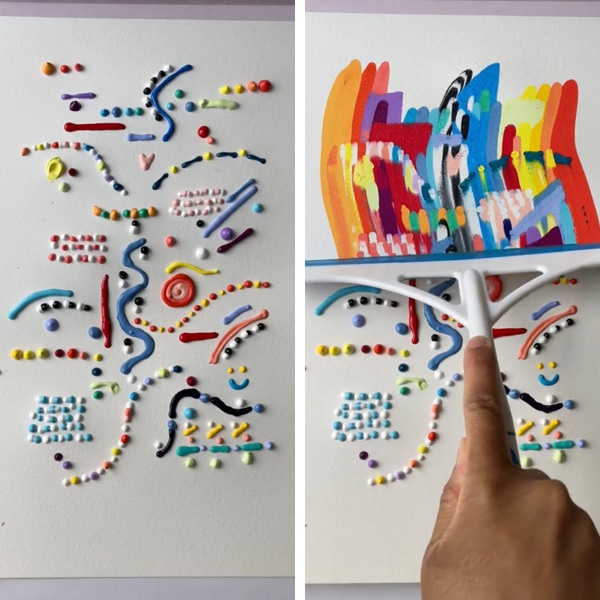
Photo: Stock Photos from PicMy/Shutterstock
This post may contain affiliate links. If you make a purchase, My Modern Met may earn an affiliate commission. Please read our disclosure for more info.
Over the course of history, the way artists have painted—and the mediums they use—has evolved. New technology and changing tastes mean that the paints used by artists have continued to diversify. But how do you know which is the right type of paint for you? Many of us are familiar with watercolor, oil, and acrylic paint, but there's so much more out there for artists to explore.
While some types of painting, like fresco and tempera, aren't practiced quite as frequently, others are seeing a resurgence. For instance, a renewed interest in hand lettering and sign painting has made enamel paint trendier than ever.
As an artist, how can you decide on the right type of paint for your artwork? Having a good grasp of the characteristics of each paint and the aesthetic they provide will help you narrow down your choices. Some painting techniques are easy for artists of all levels to pick up, while others may require more advanced technical skills.
Learn more about different kinds of paint to see what works best for you. Who knows? You just might be inspired to try a new type of painting.
Discover more about 11 different types of painting mediums that help artists express their creativity.
Oil Painting

“Night in Venice” by Leonid Afremov. Oil on canvas. (Photo: Leonid Afremov)
For centuries, artists have been using oil paint to create their masterpieces. This slow-drying medium is made from color pigments suspended in oil. Due to its long drying time, artists can take their time producing work. Oil paint is often used to create wonderful textured effects thanks to its thick consistency. Though it can be messy to work with and requires care when working with mediums like linseed oil or walnut oil, it's still beloved by artists for the rich colors it produces. So, it should come as no surprise that it's one of the most popular types of painting.
Learn how to pick the right type of oil paint in our handy guide.
Acrylic Painting

“Diamela” by Alice Pasquini. 2018. Acrylic on canvas. (Photo: Alice Pasquini)
There are a wide array of acrylic paints in terms of texture and drying time. This water-soluble paint dries quickly, is non-toxic, and is cost-effective, often making it a go-to choice for painters of all skill levels. Over time it holds up better than oil paint, as it's not prone to cracking or yellowing. There are innumerable acrylic paint techniques and by combining the paint with different mediums, artists have flexibility in the final look. Though acrylic is water resistant when completely dry on the canvas, its water-soluble nature when damp makes for easy cleanup.
Learn more about the difference between acrylic paint and oil paint, as well as the best acrylic paint for artists of all levels.
Watercolor Painting

“White Ships” by John Singer Sargent. Circa 1908. Watercolor. (Photo: Wikimedia Commons, Public domain)
Typically painted on paper, watercolors are made from pigments suspended in a water-based solution. Known for the transparent layers they create, watercolor paint remains soluble even when dry. This means that artists can make some corrections even when the painting is dry, but this also means that the finished work must be protected carefully. There are many watercolor techniques that artists use to create different works of art, from realistic portraits to washed-out landscapes. Although paper is the most common support, watercolors can also be used on surfaces like fabric, wood, leather, and vellum.
Looking for watercolors? Check our guide to the best watercolor sets.
Gouache Painting

Jacques Joseph Tissot, “Young Woman in a Rocking Chair, study for the painting ‘The Last Evening',” ca. 1873, brush with gouache and watercolor, over graphite (Photo: Getty Museum, Public domain)
While gouache is similar to watercolor in that it can be re-wetted, this type of paint dries matte and is a heavier paint due to the chalk that's incorporated into it. Gouache also has characteristics similar to acrylic in that it's an opaque paint. It's often used together with watercolor, and since it's water soluble, it requires a varnish over the top to seal the finished painting. A newer variation is acrylic gouache, which uses an acrylic-based binder that allows the paint to become water-resistant when dry.
Want to try gouache paint? Check out our guide to the best gouache sets.
Pastel Painting

Mary Cassatt, “Sleepy Baby,” 1910, pastel (Photo: Wikimedia Commons, Public domain)
Sometimes known as “dry painting,” the use of pastels has been popular since the 16th century. Their stick form and lack of drying time make them an easy and portable solution for artists. The most popular pastels—known as soft pastels—have chalk incorporated into them, but oil pastels with a waxy consistency are also available. Colors are typically blended straight onto the support and if you're looking for a watercolor-type effect, there are also water-soluble pastels. These paintings are fragile, as the pigment can lift from the surface, so should be framed under glass.
Learn more about how to paint with pastels
Encaustic Painting

Portrait of a woman from Al-Faiyum, Egypt, ca. 100–150 C.E., encaustic (Photo: Wikimedia Commons, Public domain)
This complex technique dates back to ancient Egypt and involves adding pigment to hot beeswax. The resulting paste is then typically applied to prepared wood, though canvas can also be used. Special tools are then used to shape and sculpt the liquid prior to cooling. Contemporary artists often use heat guns to extend the workability of the paint. Though encaustic—or hot wax painting—can be difficult to master, it is possible to create complex paintings full of dimension and color.
Find all the supplies you'll need to get started with encaustic painting.
Fresco Painting

Michelangelo, detail of the Sistine Chapel ceiling 1505–1508 (Photo: Wikimedia Commons, Public domain)
Fresco is an ancient technique that is perhaps best known thanks to Michelangelo's iconic Sistine Chapel Ceiling. Buon fresco involves mixing pigment with water and applying it to a still-wet layer of plaster. Used for ceiling and wall decorations, the water helps the pigment merge into the plaster, creating a permanent bond when dry. Buon fresco—or true fresco—requires artists to work quickly, as the surface is no longer paintable once the plaster dries. Another method—fresco secco—requires a binding agent such as egg, glue, or oil to attach to a dry plaster surface. This method works better on a rougher surface but is less durable.
Discover more about the history of fresco painting.
Spray Painting

Work in progress by Brus, 2013 (Photo: Jessica Stewart)
Aerosol paint—or spray paint—was first invented in 1949 and became popularized in the 1970s, when graffiti artists took advantage of this new technology. Adhering well to nearly any surface, it's most commonly used by mural artists and graffiti artists on plaster, brick, and metal. Spray paint dries quickly and is fairly weather resistant, making it a durable choice for urban artists. Today, there are many spray paint brands specifically for artists, such as MTN, Ironlak, and Belton. Available in an array of hues, artists pair the cans with special caps that control the width of the spray. It's possible to find spray paint with different effects and finishes, as well as different pressures and coverages. As spray paint does contain toxic substances, it’s always recommended for outdoor use with a mask. Several companies have also created water-based spray paint more suitable for working indoors and on canvases.
See how spray paint helped graffiti artists transform their passion into art.
Ink Wash Painting

Hasegawa Tōhaku, “Pine Trees,” 16th century, ink on paper (Photo: Wikimedia Commons, Public domain)
Also known as literati painting, ink wash finds its origins in China and East Asia. The use of black ink in calligraphy led to the popularity of brush painting using the same ink. Artists achieve different tonalities by varying the amount of ink on the brush and the pressure with which the stroke is applied. Brushstrokes are carefully studied, with calligraphy masters spending years perfecting their strokes. Though today colored inks are widely available, black is still the most common ink used.
Check out what you need to start practicing in our handy guide to hand-lettering supplies.
Tempera Painting

Sandro Botticelli, “The Birth of Venus,” ca. 1486, tempera (Photo: Wikimedia Commons, Public domain)
Though less commonly used today, tempera is one of the oldest types of painting and was traditionally created by grinding pigments into a binder. The most common type of tempera is egg tempera, which typically uses egg yolks mixed with a solution of vinegar or water as a binder. Tempera was quite popular until oil paint came into wide use in the 16th century. The fast-drying paint is applied in thin, transparent layers and is notable for its lack of color deterioration over time. Tempera continued to be used by select artists throughout history, though most people know it from Medieval and Renaissance art. Today, it is still used in the Greek and Russian Orthodox church for religious icon paintings. In the US, poster paint is sometimes called tempera, though the binders are not the same.
Intrigued by tempera? Sennelier Egg Tempera is “the authentic formulation used since the Renaissance.”
Enamel Painting
View this post on Instagram
This oil-based paint is most often used by sign painters or for decorative painting and pinstriping. It dries to a hard, high-gloss finish that is weather resistant. Enamel can be used on different surfaces like glass, ceramics, metal, wood, and canvas. Due to its toxicity, it's always suggested to work in a well-ventilated area with a mask on. There are also water-based enamels that can be used on heavier papers like cardstock. Aside from decorative work and sign painting, many fine artists have incorporated enamels into their work. Picasso and Jackson Pollack were both known to use commercial enamel paints in their work.
1-Shot, one of the most well-known types of enamel, has been a favorite of sign painters since 1948.
This article has been edited and updated.
Related Articles:
80+ Painting Ideas That Will Inspire You to Pick Up a Brush Right Now
Learn How to Paint a Colorful Sunset in Easy to Follow Steps






















































































